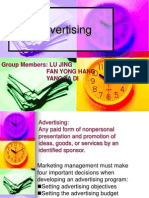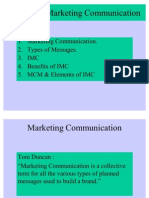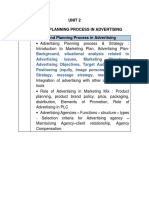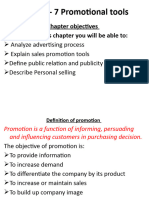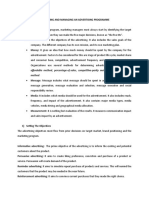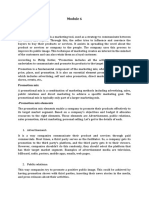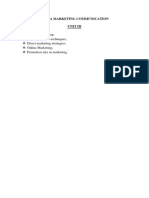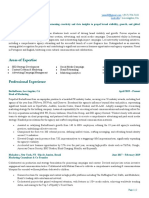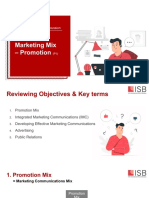0 ratings0% found this document useful (0 votes)
34 viewsPromotion
Promotion
Uploaded by
Md Omar KhoiyamThe document discusses the promotion mix and its key elements. It explains that a company's promotion mix consists of advertising, public relations, personal selling, sales promotion, and direct marketing tools used to communicate value to customers. Each element involves specific promotional tools and serves objectives like informing, persuading and reminding. The five elements are advertising, sales promotion, personal selling, public relations, and direct marketing. The document then focuses on major advertising decisions, outlining steps for setting objectives and budget, developing message strategy, selecting media, and evaluating effectiveness.
Copyright:
© All Rights Reserved
Available Formats
Download as PPT, PDF, TXT or read online from Scribd
Promotion
Promotion
Uploaded by
Md Omar Khoiyam0 ratings0% found this document useful (0 votes)
34 views21 pagesThe document discusses the promotion mix and its key elements. It explains that a company's promotion mix consists of advertising, public relations, personal selling, sales promotion, and direct marketing tools used to communicate value to customers. Each element involves specific promotional tools and serves objectives like informing, persuading and reminding. The five elements are advertising, sales promotion, personal selling, public relations, and direct marketing. The document then focuses on major advertising decisions, outlining steps for setting objectives and budget, developing message strategy, selecting media, and evaluating effectiveness.
Copyright
© © All Rights Reserved
Available Formats
PPT, PDF, TXT or read online from Scribd
Share this document
Did you find this document useful?
Is this content inappropriate?
The document discusses the promotion mix and its key elements. It explains that a company's promotion mix consists of advertising, public relations, personal selling, sales promotion, and direct marketing tools used to communicate value to customers. Each element involves specific promotional tools and serves objectives like informing, persuading and reminding. The five elements are advertising, sales promotion, personal selling, public relations, and direct marketing. The document then focuses on major advertising decisions, outlining steps for setting objectives and budget, developing message strategy, selecting media, and evaluating effectiveness.
Copyright:
© All Rights Reserved
Available Formats
Download as PPT, PDF, TXT or read online from Scribd
Download as ppt, pdf, or txt
0 ratings0% found this document useful (0 votes)
34 views21 pagesPromotion
Promotion
Uploaded by
Md Omar KhoiyamThe document discusses the promotion mix and its key elements. It explains that a company's promotion mix consists of advertising, public relations, personal selling, sales promotion, and direct marketing tools used to communicate value to customers. Each element involves specific promotional tools and serves objectives like informing, persuading and reminding. The five elements are advertising, sales promotion, personal selling, public relations, and direct marketing. The document then focuses on major advertising decisions, outlining steps for setting objectives and budget, developing message strategy, selecting media, and evaluating effectiveness.
Copyright:
© All Rights Reserved
Available Formats
Download as PPT, PDF, TXT or read online from Scribd
Download as ppt, pdf, or txt
You are on page 1of 21
The Promotion Mix
A company’s total promotion mix—also called its marketing
communications mix—consists of the specific blend of
advertising, public relations, personal selling, sales
promotion, and direct-marketing tools that the company uses
to persuasively communicate customer value and build
customer relationships.
The primary roles of a service firm’s promotional strategy is to-
Inform
Persuade
Remind
Action / Purchase
Through
Non personal source: Communication channels that are
considered impersonal, such as TV advertising or printed
information.
Personal source: Communication channels that are
considered personal, such as a face-to-face encounter.
The Promotion Mix
Elements of Marketing Promotion
The are five elements of promotional mix. They are discussed
as follows:
Advertising: Any paid form of nonpersonal presentation and
promotion of ideas, goods, or services by an identified sponsor.
Sales promotion: Short-term incentives to encourage the
purchase or sale of a product or service.
Personal selling: Personal presentation by the firm’s sales
force for the purpose of making sales and building customer
relationships.
Public relations: Building good relations with the company’s
various publics by obtaining favorable publicity, building up a
good corporate image, and handling or heading off unfavorable
rumors, stories, and events.
Direct marketing: Direct connections with carefully targeted
individual consumers to both obtain an immediate response and
cultivate lasting customer relationships—the use of direct mail,
the telephone, direct-response television, e-mail, the Internet, &
other tools to communicate directly with specific consumers.
Elements of Marketing Promotion
Elements of Marketing Promotion
Each category involves specific promotional tools
used to communicate with customers. For example,
advertising includes broadcast, print, Internet,
outdoor, and other forms. Sales promotion includes
discounts, coupons, displays, and demonstrations.
Personal selling includes sales presentations, trade
shows, and incentive programs. Public relations
(PR) includes press releases, sponsorships, special
events, and Web pages. And direct marketing
includes catalogs, telephone marketing, kiosks, the
Internet, mobile marketing, and more.
Major Advertising Decisions
Major Advertising Decisions
1. Setting Advertising Objectives: The first step is to set
advertising objectives. These objectives should be based on past
decisions about the target market, positioning, and the marketing
mix, which define the job that advertising must do in the total
marketing program. The overall advertising objective is to help
build customer relationships by communicating customer value.
Here, we discuss specific advertising objectives. An advertising
objective is a specific communication task to be accomplished
with a specific target audience during a specific period of time.
Advertising objectives can be classified by primary purpose—
whether the aim is to inform, persuade, or remind.
2. Setting the Advertising Budget: After determining its
advertising objectives, the company next sets its advertising
budget for each product. Advertising budget is the money and
other resources allocated to a product or company advertising
program. There are four commonly used methods for setting
promotion budgets:
– Affordable method: Setting the promotion budget at the level
management thinks the company can afford.
– Percentage-of-sales method: Setting the promotion budget at a certain
percentage of current or forecasted sales or as a percentage of the unit
sales price.
– Competitive-parity method: Setting the promotion budget to match
competitors’ outlays.
Major Advertising Decisions
– Objective-and-task method: Developing the promotion
budget by (1) defining specific objectives, (2) determining the
tasks that must be performed to achieve these objectives, and
(3) estimating the costs of performing these tasks. The sum of
these costs is the proposed promotion budget.
3. Message Strategy: The first step in creating effective
advertising messages is to plan a message strategy—to decide
what general message will be communicated to consumers. The
purpose of advertising is to get consumers to think about or react
to the product or company in a certain way. People will react
only if they believe that they will benefit from doing so. Thus,
developing an effective message strategy begins with identifying
customer benefits that can be used as advertising appeals.
Ideally, advertising message strategy will follow directly from
the company’s broader positioning and customer value strategies.
4. Selecting Advertising Media: The major steps in advertising
media selection are (1) deciding on reach, frequency, and impact;
(2) choosing among major media types; (3) selecting specific
media vehicles; and (4) deciding on media timing.
5. Evaluating Advertising Effectiveness and Return on
Advertising Investment: Advertising accountability and return
on advertising investment have become hot issues for most
Major Advertising Decisions
companies. Two separate recent studies show that advertising
effectiveness has fallen 40 percent over the past decade and that
37.3 percent of advertising budgets are wasted. This leaves top
management and many companies asking their marketing
managers, “How do we know that we’re spending the right
amount on advertising?” and “What return are we getting on
our advertising investment?”
You might also like
- Dot and KeyDocument6 pagesDot and Keygelin239530% (1)
- PricingDocument19 pagesPricingMd Omar KhoiyamNo ratings yet
- Chapter 13 NotesDocument5 pagesChapter 13 Notesfauzi_aimanNo ratings yet
- Advertising: Group Members: LU JING Fan Yong Hang Yang Ya DiDocument18 pagesAdvertising: Group Members: LU JING Fan Yong Hang Yang Ya DiMax KiewNo ratings yet
- Promotion, Promotion Mix & Promotional Budget.: Shince Peter MsDocument21 pagesPromotion, Promotion Mix & Promotional Budget.: Shince Peter MsshincepetermsNo ratings yet
- AdvertisementDocument76 pagesAdvertisementChinthuUnnikrishnanNo ratings yet
- Thuyet Trinh MarketingDocument9 pagesThuyet Trinh MarketingNguyen GiangNo ratings yet
- UNit 3 CBMC 1Document11 pagesUNit 3 CBMC 1Trending VideosNo ratings yet
- Chapter 12 - Outbound Marketing CommunicationsDocument11 pagesChapter 12 - Outbound Marketing CommunicationsGarima joshiNo ratings yet
- MBA202 Marketing Management Unit VDocument62 pagesMBA202 Marketing Management Unit Vmuskansingh0611No ratings yet
- Define Marketing CommunicationDocument23 pagesDefine Marketing CommunicationLakkhanRobidasNo ratings yet
- Integrated Marketing Communication Planning ProcessDocument20 pagesIntegrated Marketing Communication Planning ProcessShyam ChoudharyNo ratings yet
- Unit-4 MIP NewDocument23 pagesUnit-4 MIP NewVeena ReddyNo ratings yet
- What Is AdvertisingDocument12 pagesWhat Is AdvertisingMir AqibNo ratings yet
- Integrated Marketing Communications (Imc)Document27 pagesIntegrated Marketing Communications (Imc)api-291598576No ratings yet
- Promotion MixDocument28 pagesPromotion MixWho CaresNo ratings yet
- Factors Influencing Promotion MixDocument3 pagesFactors Influencing Promotion MixManas MohapatraNo ratings yet
- MM, Group No. 10 (Marketing Commu. Mix) in DetailDocument36 pagesMM, Group No. 10 (Marketing Commu. Mix) in DetailJaimin VaghelaNo ratings yet
- Integrated Marketing CommunicationDocument26 pagesIntegrated Marketing Communicationanamikasharma1970No ratings yet
- Module 5 NotesDocument20 pagesModule 5 NotesHarshith AgarwalNo ratings yet
- Promotion Push Strategy and Human Resource Managements Docs.Document6 pagesPromotion Push Strategy and Human Resource Managements Docs.Lizcel CastillaNo ratings yet
- Unit 2 Strategy Planning Process in Advertising 2 Strategy and Planning Process in AdvertisingDocument32 pagesUnit 2 Strategy Planning Process in Advertising 2 Strategy and Planning Process in AdvertisingMilan JainNo ratings yet
- Chapter 7 Promotional Tools.Document16 pagesChapter 7 Promotional Tools.kichuubmcNo ratings yet
- Promotion AdvertisingDocument20 pagesPromotion AdvertisingSHREYASH DESHPANDENo ratings yet
- 2.ppt Marketing CommunicationsDocument38 pages2.ppt Marketing CommunicationsPreemal LoboNo ratings yet
- UNIT5Document44 pagesUNIT5anjukumari94314No ratings yet
- Developing and Managing An Advertising ProgrammeDocument3 pagesDeveloping and Managing An Advertising ProgrammemierameaNo ratings yet
- Bài Nói 14+15Document4 pagesBài Nói 14+15Thao Dang Phan HuongNo ratings yet
- MM Unit VDocument33 pagesMM Unit Vmrrex1430No ratings yet
- Communicating ValuesDocument58 pagesCommunicating Valuesnoushad kNo ratings yet
- Integrated Marketing Communication ToolsDocument21 pagesIntegrated Marketing Communication ToolsMohamed AhmedNo ratings yet
- IMC NotesDocument11 pagesIMC NotesAvinash GurjarNo ratings yet
- Chapter 12Document10 pagesChapter 12Minh TrangNo ratings yet
- Marketing ManagementDocument69 pagesMarketing ManagementNaveed IqbalNo ratings yet
- Promotion: Definition: - Promotion Is A Marketing Tool, Used As A Strategy To Communicate BetweenDocument17 pagesPromotion: Definition: - Promotion Is A Marketing Tool, Used As A Strategy To Communicate BetweenNeenu nirmalNo ratings yet
- Marketing Managemen1esson 11bDocument6 pagesMarketing Managemen1esson 11bnasayaobeladonaNo ratings yet
- Mass Communication: by Sarit KumarDocument17 pagesMass Communication: by Sarit KumarKarun ReddyNo ratings yet
- Promotion MixDocument23 pagesPromotion MixKundan JhaNo ratings yet
- Unit Iii Synopsis 4Document18 pagesUnit Iii Synopsis 4Samman GuptaNo ratings yet
- Unit 3Document18 pagesUnit 3abhigupta0523No ratings yet
- Overview of Advertising ManagementDocument21 pagesOverview of Advertising ManagementsawmyaNo ratings yet
- integrated marketing and communication short notesDocument7 pagesintegrated marketing and communication short notesNouman QureshiNo ratings yet
- Advantages of Marketing Public RelationsDocument4 pagesAdvantages of Marketing Public RelationsSayem HuqueNo ratings yet
- The 4 Ps of Marketing Are ProductDocument5 pagesThe 4 Ps of Marketing Are Productalen paulNo ratings yet
- Integrated Marketing Communications Unit One NotesDocument6 pagesIntegrated Marketing Communications Unit One NotesMohd SabirNo ratings yet
- AdvertisingDocument6 pagesAdvertisingRohit AggarwalNo ratings yet
- MMC Unit 3Document7 pagesMMC Unit 3vaibhavsreenivas03No ratings yet
- Week 9 HandoutDocument14 pagesWeek 9 HandoutEndrei Clyne MerculloNo ratings yet
- Unit VDocument17 pagesUnit VM.C.Chenbaga neelaNo ratings yet
- MM IV, V chatGPTDocument75 pagesMM IV, V chatGPTARUP ROYNo ratings yet
- Unit 3 CB & IMCDocument42 pagesUnit 3 CB & IMCayush.kaushikpgdm22-24No ratings yet
- The Advertising Department - A ClientDocument5 pagesThe Advertising Department - A ClientTitay SamNo ratings yet
- Response Paper: Advertising and Marketing StrategiesDocument2 pagesResponse Paper: Advertising and Marketing Strategiesoumaima ajbilouNo ratings yet
- IM1019 L9 Engaging Customers and Communicating Customer ValueDocument31 pagesIM1019 L9 Engaging Customers and Communicating Customer Valuephamyenvy2012005No ratings yet
- Decision Models, Sales Response & Decay ModelsDocument3 pagesDecision Models, Sales Response & Decay ModelsRamadurga PillaNo ratings yet
- Unit IV: Marketing Communication: Sandeep Kumar Singh, Assistant Professor, Dept. of Commerce, CHRIST UniversityDocument32 pagesUnit IV: Marketing Communication: Sandeep Kumar Singh, Assistant Professor, Dept. of Commerce, CHRIST Universitynishant haweliaNo ratings yet
- Kotler Fmm6e Im 15Document9 pagesKotler Fmm6e Im 15BerikNo ratings yet
- Integrated Marketing Communication Amp Case Study On Bajaj Pulsar.Document37 pagesIntegrated Marketing Communication Amp Case Study On Bajaj Pulsar.Animesh SamalNo ratings yet
- Unit - VIDocument31 pagesUnit - VIarnav.gopalNo ratings yet
- Promotion MarketingDocument11 pagesPromotion MarketingKailas S BhatNo ratings yet
- ProductDocument36 pagesProductMd Omar KhoiyamNo ratings yet
- Marketing MGT OrientationDocument16 pagesMarketing MGT OrientationMd Omar KhoiyamNo ratings yet
- Marketing EnvDocument19 pagesMarketing EnvMd Omar KhoiyamNo ratings yet
- 43 UDEMY PAID COURSES COUPONS Will Expire Soon Enroll AsapDocument3 pages43 UDEMY PAID COURSES COUPONS Will Expire Soon Enroll Asapmtahatayyab62No ratings yet
- Yann+Resume (V1)Document2 pagesYann+Resume (V1)Kumod MarskoleNo ratings yet
- PMK PromotionsDocument41 pagesPMK PromotionsTran PhamNo ratings yet
- Proactiv: How Have Three Critical Marketing Decisions Shaped A New Venture's Future?Document3 pagesProactiv: How Have Three Critical Marketing Decisions Shaped A New Venture's Future?Ritik RajNo ratings yet
- Chapter: 1 Introduction 1.1 Background of The StudyDocument19 pagesChapter: 1 Introduction 1.1 Background of The StudyMadhukumarNo ratings yet
- Company Credential 2024Document74 pagesCompany Credential 2024Muhammad Ramdhan CahyoNo ratings yet
- Choose The Correct Answer, and Then Shade The Proper Circle at Your Electronic Answer SheetDocument2 pagesChoose The Correct Answer, and Then Shade The Proper Circle at Your Electronic Answer SheetBli blaNo ratings yet
- BAE SOJU - Digital Activation Planning Proposal 2022Document115 pagesBAE SOJU - Digital Activation Planning Proposal 2022Jimmi KzNo ratings yet
- Communication Management PlanDocument3 pagesCommunication Management Planagukos augustus100% (1)
- Event ProposalDocument11 pagesEvent ProposalLaiba FatimaNo ratings yet
- Markiit Satish GoyalDocument3 pagesMarkiit Satish GoyalSatish GoyalNo ratings yet
- Chapter 1 - An Introduction To Integrated Marketing CommunicationsDocument20 pagesChapter 1 - An Introduction To Integrated Marketing CommunicationsDũng Hà AnhNo ratings yet
- Value Chain Development: Brand and BrandingDocument3 pagesValue Chain Development: Brand and BrandingBint OsmanNo ratings yet
- Introducing The SmartEco BottleDocument8 pagesIntroducing The SmartEco BottleGaurav KumarNo ratings yet
- TV Commercial Critique PaperDocument2 pagesTV Commercial Critique PaperRaelle LageraNo ratings yet
- Suraj Gowda ResumeDocument1 pageSuraj Gowda ResumeAli ShahNo ratings yet
- Myglamm Channel StrategyDocument4 pagesMyglamm Channel StrategyAMITESH RANJANNo ratings yet
- 5 - How The Impact of Social Media Influencer Disclosures Changes Over Time...Document15 pages5 - How The Impact of Social Media Influencer Disclosures Changes Over Time...Reine Dominique VicuñaNo ratings yet
- Pcomm-Week6 Activity#1Document3 pagesPcomm-Week6 Activity#1Tria BasilioNo ratings yet
- Swot Analysis of Bingo ChipsDocument2 pagesSwot Analysis of Bingo ChipsSRIRAG S PUDHUVEL 21BAF043No ratings yet
- TikTok For Concrete Coating Companies CleanDocument2 pagesTikTok For Concrete Coating Companies CleanelijahNo ratings yet
- BURTENSHAW-The Fundamentals of Creative Advertising (Ken Burtenshaw, Caroline Barfoot, Nik Mahon) (Z-Library)Document186 pagesBURTENSHAW-The Fundamentals of Creative Advertising (Ken Burtenshaw, Caroline Barfoot, Nik Mahon) (Z-Library)carolina orlandoNo ratings yet
- Advertising Unit 1Document26 pagesAdvertising Unit 1Harshit KumarNo ratings yet
- Copywriting Notes BMMDocument2 pagesCopywriting Notes BMMkingproduction880No ratings yet
- Company ProfileDocument48 pagesCompany ProfileKaranMPaiNo ratings yet
- Advertising Management Unit-5Document30 pagesAdvertising Management Unit-5aryan7209singhNo ratings yet
- Draft 1 - Group 2Document8 pagesDraft 1 - Group 2nguyengiaphuc298No ratings yet
- Addis Ababa University: Graduate School of Journalism and CommunicationDocument70 pagesAddis Ababa University: Graduate School of Journalism and Communicationoftae dawitNo ratings yet
- CBMC - U3 - L3,4 - Advertising - Meaning, Nature, Scope & Classification - 8 Jan 2024Document56 pagesCBMC - U3 - L3,4 - Advertising - Meaning, Nature, Scope & Classification - 8 Jan 2024shubhdeep jainNo ratings yet



